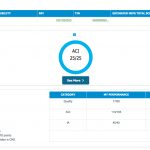Participation in a QCDR, such as RISE, allows you to collect 30 points immediately through two population management activities:
- Use of a QCDR to generate regular performance feedback that summarizes local practice patterns and treatment outcomes, including those of vulnerable populations. Weight (high): 20 points.
- Participation in a QCDR; clinical data registry; or other registry run by government agencies, such as the FDA, or private entities, such as a hospital or medical or surgical society; and using the data for quality improvement (e.g., comparative analysis across specific patient populations for adverse outcomes after an outpatient surgical procedure and corrective steps to address an adverse outcome). Weight (medium): 10 points.
For a full list of CPIAs, visit the CMS website.
Advancing Care Information
Satisfying ACI requirements will largely depend on the individual practice’s EHR system.
You must complete one of two options for ACI: 1) ACI Objectives and Measures or 2) 2017 ACI Transition Objectives and Measures. The length of time that your practice engaged in Meaningful Use will determine which of the two pathways you will take to satisfy this category.
You can report the ACI Objectives and Measures if you have:
- Technology certified to the 2015 edition; or
- A combination of technologies from the 2014 and 2015 editions that support these measures.
You can report the 2017 ACI Transition Objectives and Measures if you have:
- Technology certified to the 2015 edition;
- Technology certified to the 2014 edition; or
- A combination of technologies from 2014 and 2015 editions.
By participating in a QCDR, such as RISE, you are eligible for a 5% bonus in this category.
If you need help identifying your EHR edition or you would like to learn more about this category, follow this link.
Pick Your Pace for 2017
The final rule for MACRA calls for a transition year so that providers may become accustomed to the new payment program. There are four options that rheumatologists can pick from to begin the transition into MIPS:
- Non-Participation: This results in a 4% negative payment adjustment.
- Test Data Submission: Providers will avoid a negative payment adjustment, but will not be eligible for a bonus. This also requires one measure on one patient for one visit, or you can submit one improvement activity.
- Partial Data Submission: Submit 90 days of data, and you may earn a neutral or positive payment adjustment. For partial reporting, you must submit the required data for all three required categories in 2017:
(a) Quality: Six measures, including an outcome/high-priority measure;
(b) ACI: Four to five measures, depending on the option applicable to your EHR; and
(c) Clinical Practice Improvement Activities: Providers may choose two highly weighted or four medium-weighted activities. - Full Data Submission: Submit a full year of 2017 data to Medicare, and you may earn a positive payment adjustment. The reporting requirements are the same as for partial data submission (3a–c above), but for the entire year.
Want to Learn More?
If you are interested in joining RISE or have questions about the payment program in 2017, contact ACR staff at [email protected]. If you would like to learn more about the new Quality Payment Program, visit the Quality Payment Program information section on the CMS’s website.


